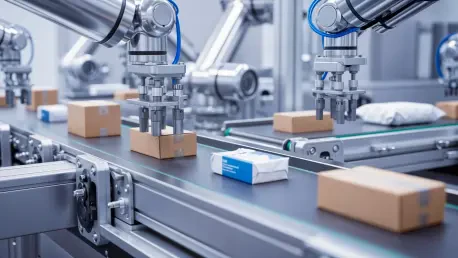Market Snapshot: The Rise of Adaptive Systems in Industry
Imagine a warehouse during peak season, grappling with sudden demand spikes while struggling to reconfigure outdated automation systems, a scenario all too common in today’s fast-evolving industrial landscape where agility can mean the difference between thriving and merely surviving. Modular automation has emerged as a pivotal solution, reshaping how industries manage change, scale operations, and prepare for technological shifts. This market analysis delves into the driving forces behind this transformative technology, examining current trends, data-driven insights, and projections that highlight its growing dominance. By unpacking the dynamics of modular systems, the goal is to provide a clear understanding of their impact on operational efficiency and long-term competitiveness across diverse sectors.
Current Market Dynamics: Key Trends Shaping Modular Automation
Adoption Surge: Flexibility as a Competitive Edge
The industrial automation market is witnessing a significant shift toward modular systems, driven by the urgent need for adaptability in volatile environments. Unlike traditional setups that lock businesses into rigid processes, modular automation offers independent, compatible units that can be reconfigured with minimal disruption. Recent industry reports suggest that sectors like logistics and manufacturing are increasingly prioritizing systems that allow rapid adjustments to supply chain hiccups or consumer demand changes. For instance, warehouses can rearrange layouts on short notice to handle unexpected order surges, maintaining smooth operations during high-pressure periods. This trend reflects a broader push for resilience, as companies seek to minimize downtime and avoid the costly overhauls associated with legacy systems.
Scalability Metrics: Aligning Growth with Demand
Another defining trend in the market is the scalability of modular automation, which allows businesses to expand operations incrementally without committing to massive upfront investments. Data indicates that companies adopting these systems report up to a 30% reduction in operational costs due to optimized material flow and enhanced throughput. In grocery retail, for example, modular setups enable seamless scaling during holiday peaks, ensuring order accuracy and shorter lead times without overextending resources. This pay-as-you-grow model mitigates financial risk, aligning automation investments with actual market needs. However, integration challenges during expansion phases remain a concern, underscoring the importance of strategic planning to ensure compatibility with existing infrastructure.
Technology Integration: Paving the Way for Innovation
The ability of modular automation to integrate emerging technologies is fueling its market growth, positioning it as a future-ready solution. Current adoption rates show a rising interest in pairing these systems with innovations like robotics and the Internet of Things (IoT), enabling real-time adaptability without workflow interruptions. In industries such as tire manufacturing, streamlined material handling through modular designs supports the incorporation of advanced tech, enhancing precision and efficiency. Market analysis reveals that businesses leveraging such integrations are better equipped to handle rapid technological advancements, avoiding obsolescence. This trend highlights a shift toward long-term strategic investments, as companies recognize the durability and versatility of modular frameworks.
Market Projections: Future Growth and Emerging Opportunities
AI-Driven Optimization: The Next Frontier
Looking ahead, the integration of artificial intelligence (AI) is set to redefine the modular automation market by enabling predictive analytics and self-optimizing systems. Industry forecasts suggest that AI-enhanced modular solutions could increase operational efficiency by up to 25% over the next few years, as they analyze vast datasets to anticipate demand shifts. This capability allows businesses to proactively adjust workflows, reducing waste and maximizing resource use. The convergence of AI with modular systems is expected to create a ripple effect across sectors, from logistics to retail, where real-time decision-making will become a cornerstone of competitive strategy. As this technology matures, early adopters are likely to gain a significant edge in dynamic markets.
Sustainability Focus: Balancing Profit and Planet
Sustainability is emerging as a critical driver in the modular automation space, with energy-efficient designs gaining traction amid rising regulatory pressures. Market projections indicate that eco-conscious automation solutions could capture a substantial share of investments by 2027, as companies aim to reduce carbon footprints while maintaining profitability. Modular systems, with their ability to minimize waste through precise material handling, align closely with environmental goals. For instance, automated warehouses using these setups report lower energy consumption during peak operations. This trend not only addresses ecological concerns but also appeals to stakeholders prioritizing corporate responsibility, shaping purchasing decisions in the industrial sector.
Sector-Specific Expansion: Tailored Solutions on the Rise
The market for modular automation is poised for robust growth in specific industries, with tailored applications driving adoption rates. In grocery retail, projections point to a surge in demand for systems that support rapid scalability during seasonal fluctuations, ensuring faster order fulfillment. Meanwhile, tire manufacturing is expected to see increased investment in modular setups that streamline complex production lines while maintaining agility. Data suggests that sector-specific solutions will account for a significant portion of market expansion, as providers develop customized offerings to meet unique operational challenges. This targeted approach is likely to accelerate the technology’s penetration across diverse global markets.
Reflecting on the Market Impact: Strategic Insights for Stakeholders
Looking back, the analysis of modular automation reveals a transformative force that redefines industrial efficiency through adaptability, scalability, and technological integration. The market trends demonstrate a clear shift away from rigid systems, as businesses embrace solutions that support dynamic growth and innovation. Projections into the coming years paint a picture of continued evolution, with AI and sustainability emerging as pivotal influences on investment and adoption. For stakeholders, the actionable takeaway is to prioritize pilot implementations of modular systems to test compatibility and build workforce readiness before full-scale deployment. Partnering with experienced providers for tailored solutions proves essential, while planning for emerging tools like AI ensures long-term relevance. By acting on these insights, companies position themselves to navigate market uncertainties and secure a lasting competitive advantage.









